MyPortugalHoliday.com
The best independent guide to Central Portugal
MyPortugalHoliday.com
The best independent guide to Central Portugal
Tomar: Sights, attractions and things to see for 2026
Tomar is where Portugal's destiny was forged, a town built by warrior monks whose red cross would one day sail on the caravels that discovered new worlds. This remarkable Templar city lies 140km northeast of Lisbon, its medieval streets climbing toward the hilltop fortress-monastery that served as headquarters for the knights who financed the Age of Discoveries.
The mighty Convento de Cristo dominates the skyline, while below, the compact historic centre holds treasures of its own, from one of Portugal’s oldest synagogues to riverside chapels and tranquil gardens. Though small enough to explore in a day, Tomar's significance to Portuguese history, and the fascinating sites scattered throughout the surrounding region, make it worthy of a longer stay.
Whether you have one day or three, this guide will help you discover the very best of Tomar and the fascinating attractions of the surrounding region.
Related articles: A day trip to Tomar
Highlights of Tomar
The following are the highlights of Tomar which you would want to see in a day trip or stay here. A full description of them is provided later in the guide.
Convento de Cristo
A UNESCO World Heritage masterpiece that served as the headquarters of the Knights Templar and later the Order of Christ. This vast complex showcases eight centuries of Portuguese architecture, from Romanesque to Manueline and Renaissance styles. Its most striking feature is the elaborately carved Manueline window in the Chapter House, an iconic symbol of Portugal's Age of Discovery.
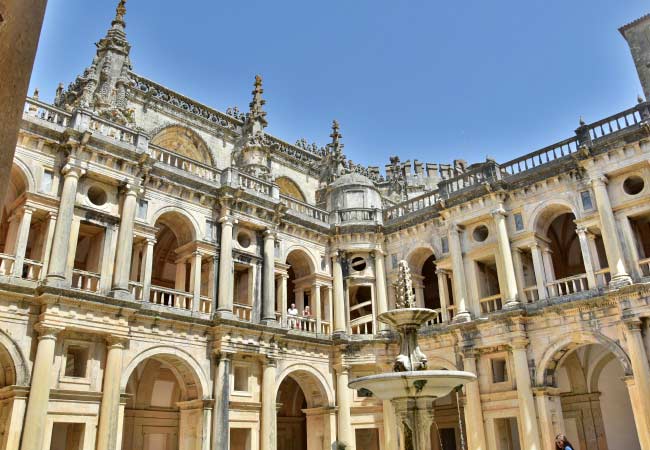
Castelo de Tomar
Gualdim Pais's 1160 fortress proved its worth in 1190, successfully repelling Moorish forces with defensive innovations learned during the Crusades. Its massive walls and distinctive round towers merge seamlessly with the convent above, creating an imposing citadel that dominates Tomar's skyline.
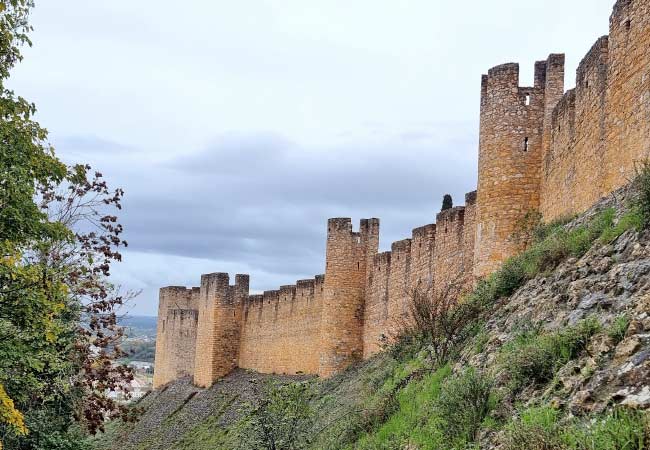
Charola (Round Church)
This extraordinary 16-sided Templar rotunda was designed so knights could attend mass without dismounting their horses. Modeled after Jerusalem's Holy Sepulchre, its interior dazzles with 16th-century paintings and gilt decorations that transform the austere military chapel into a jewel box of Renaissance art.
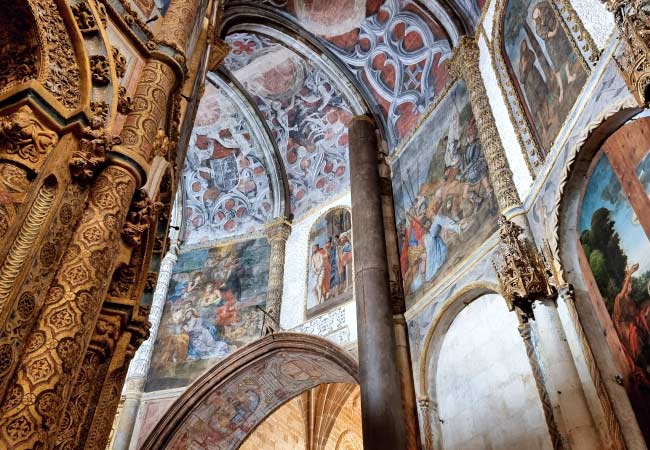
Sinagoga de Tomar
Portugal's best-preserved medieval synagogue features remarkable acoustic engineering, with four clay jars embedded in the corners to amplify prayers throughout the space. Built in the mid-15th century, its four columns represent the matriarchs of Israel, while Gothic vaulting creates an atmosphere of hushed reverence
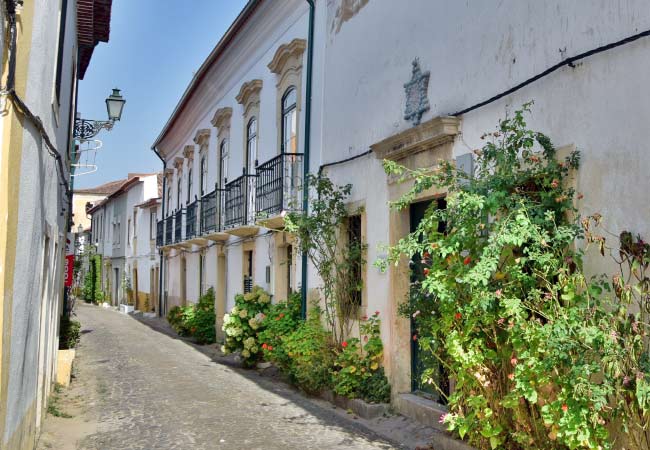
Igreja de São João Baptista
Commanding Republic Square since the 15th century, this church boasts a flamboyant Manueline portal adorned with fantastical creatures and intricate natural motifs. Inside, six magnificent panels by Renaissance master Gregório Lopes and an ornate limestone pulpit decorated like contemporary silverware reward careful examination.
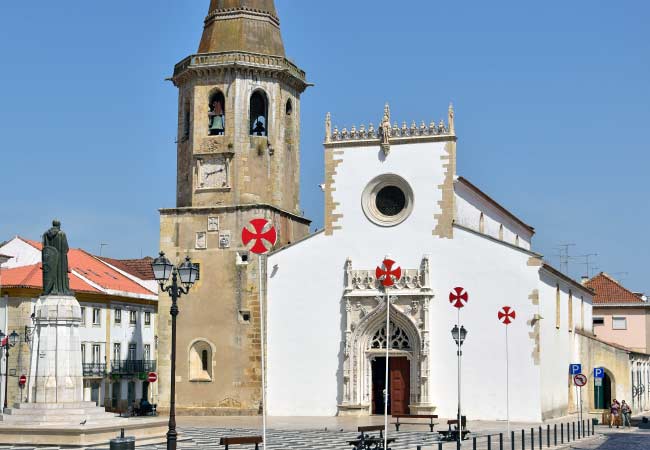
Igreja de Santa Maria dos Olivais
The Templars' pantheon holds extraordinary spiritual authority; a 1455 papal bull designated it "Mother Church" for all territories discovered by Portugal. Gothic sobriety defines its exterior, while inside lie the tombs of Templar masters, including founder Gualdim Pais beneath a worn stone slab.
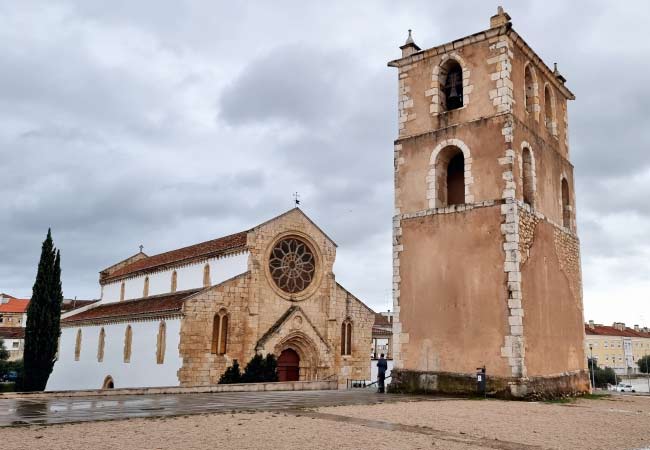
Mata Nacional dos Sete Montes
Once the convent's walled cultivation grounds and rumoured site of secret Templar rituals, this 39-hectare forest now offers shaded walking trails and castle views. Its centerpiece is the Charolinha, a miniature stone temple, that provides a romantic folly perfect for contemplation away from the crowds.
Below is an interactive map highlighting the major tourist attractions of Tomar (Note: Zoom in or out to see all markers.)
Legend 1) Convento de Cristo 2) Castelo de Tomar 3) Claustro dos Corvos 4) Charola (Round Church) 5) Igreja de São João Baptista 6) Sinagoga de Tomar 7) Mata Nacional dos Sete Montes 8) Câmara Municipal 9) Igreja de Santa Maria dos Olivais 10) Ermida de Nossa Senhora da Conceição 11) Museu dos Fósforos 12) Mouchão Parque 13) Igreja do Convento de São Francisco 14) Capela de Santa Iria 15) Ponte Velha (Old Bridge) 16) Núcleo de Arte Contemporânea
Beyond Tomar - Sights and attractions of the Tomar region
The region surrounding Tomar boasts an array of fascinating historical sites and natural attractions, all within easy driving distance. The location of all of these sights is provide in the map at the end of this section.
Castelo de Almourol
Rising dramatically from a granite islet in the Tagus River, this remarkably preserved 12th-century Templar fortress is accessible only by boat. Its imposing walls and towers create an unforgettable silhouette reflected in the water, offering an atmospheric journey into the legendary age of the Knights Templar.
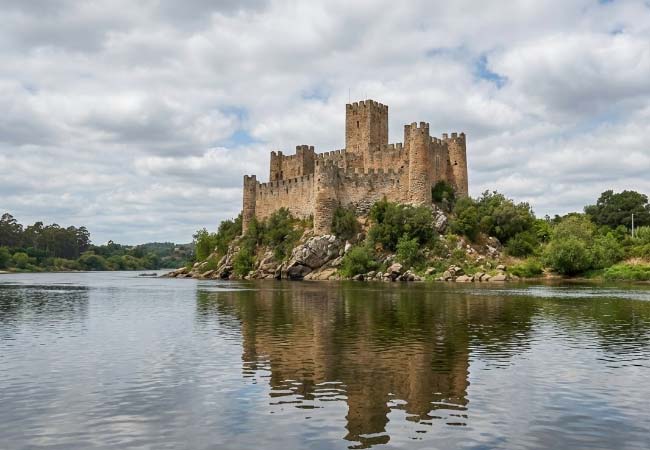
Fátima
One of Catholicism's most significant pilgrimage sites, where three young shepherds reported seeing the Virgin Mary in 1917. The vast sanctuary complex includes the original Chapel of Apparitions and the impressive Basilica of Our Lady of the Rosary.
Aqueduto dos Pegões
An engineering marvel near Tomar that stretches 6km across the undulating landscape. Built in the 17th century, this double-tiered aqueduct reaches heights of 30 meters and once supplied water to the Convent of Christ. It is possible to walk along sections of its upper level.
Castelo de Ourém
Instantly recognisable by its twin towers connected by a Gothic bridge, this hilltop fortress creates one of Portugal's most striking silhouettes. Rebuilt as a noble residence in the 15th century the complex offers panoramic views across the region.
Grutas da Moeda
A network of limestone caves where you'll find extraordinary rock formations sculpted by water over millennia. Discovered by hunters in 1971, the caves maintain a constant 18°C temperature and are accessible through 45-minute guided tours that showcase their illuminated natural features.
Albufeira do Castelo do Bode
Central Portugal's great lake stretches 60km through pine-forested valleys. Pristine waters and hidden beaches make it a paradise for swimming, sailing, and lazy waterside picnics. Numerous river beaches and picnic spots dot its shoreline, offering perfect escapes on a summer afternoon.
Pegadas de Dinossáurios de Ourém
Jurassic giants left their footprints in this limestone rocks, preserved for 175 million years. These aren't just random prints; the stone preserves over twenty distinct trackways, allowing you to trace the clear path of giant herbivores walking across what was once a muddy lagoon.
Praia Fluvial da Aldeia do Mato
Set beautifully on the pine-fringed shores of the Castelo do Bode reservoir. Its main attraction is a unique floating platform with enclosed pools, ensuring safe swimming for everyone.
Wine tourism
Herdade dos Templários
Embracing the region's legendary history, this modern winery produces a range of acclaimed Tejo wines just a short drive from Tomar. Visitors can book a guided tour to explore the vineyards and state-of-the-art cellars, learning about the winemaking process from grape to glass. The experience culminates in a structured tasting of their portfolio, making it an excellent introduction to the region's wine - www.herdadedostemplarios.pt
Quinta Vale do Armo
Set in the rolling hills near Tomar, this boutique winery combines traditional methods with modern technology. The estate offers personalized wine tastings, vineyard tours, and insights into their sustainable wine-making practices. Their tasting room provides panoramic views of the vineyards. For visits, book through: valedoarmo.com
Quinta Casal das Freiras
With a history stretching back to the 17th century, this family-run estate offers an authentic taste of Tomar's winemaking heritage. Its name, meaning "Estate of the Nuns," hints at its past supplying the local convents, a connection that adds to its charm. Visitors are welcomed for tours and tastings that demonstrate a passion for local grape varieties and traditional methods - casaldasfreiras.pt
Tomar region map
Use this interactive map to discover the best day trip destinations from your Tomar base. (Note: Zoom out to see all of the markers)
Legend 1) Castelo de Almourol (Castle)
2) Basílica de Nossa Senhora de Fátima
3) Aqueduto dos Pegões (aquaduct)
4) Castelo de Ourém (Castle)
5) Grutas da Moeda (caves)
6) Albufeira do Castelo do Bode (Reservoir)
7) Pegadas de Dinossáurios de Ourém (Dinosaur trail)
8) Casa da Lúcia - Fatima
9) Museu de Cera - Fatima
10) Praia Fluvial do Agroal (river beach)
11) Bar das Caraíbas (swimming area)
12) Óbidos
13) Grutas de Mira de Aire (Caves)
14) Salinas de Rio Maior
15) Mosteiro de Alcobaça
16) Mosteiro da Batalha
17) Grutas de Santo António
18) São Martinho do Porto
19) Nazaré
Wineries: 20) Herdade dos Templários (Quinta do Cavalinho) 21) Quinta Vale do Armo 22) Quinta Casal das Freiras
In depth guide to the sights of Tomar
Convento de Cristo
The majestic Convento de Cristo stands high above Tomar and is one of Portugal's finest historical monuments. This architectural masterpiece spans eight centuries of Portuguese history, seamlessly blending military, religious, and artistic elements.
Founded in 1160 as a Templar stronghold, the complex initially served as a crucial defensive structure along the Christian-Muslim frontier. Its imposing medieval walls, crenellated battlements, and robust towers proved their worth during the successful defence against Moorish forces in 1190. The complex's most striking feature is the unique 16-sided Charola, a circular church that serves as its spiritual heart. This extraordinary rotunda, inspired by the Church of the Holy Sepulchre in Jerusalem, reflects the Templars' connection to the Holy Land.
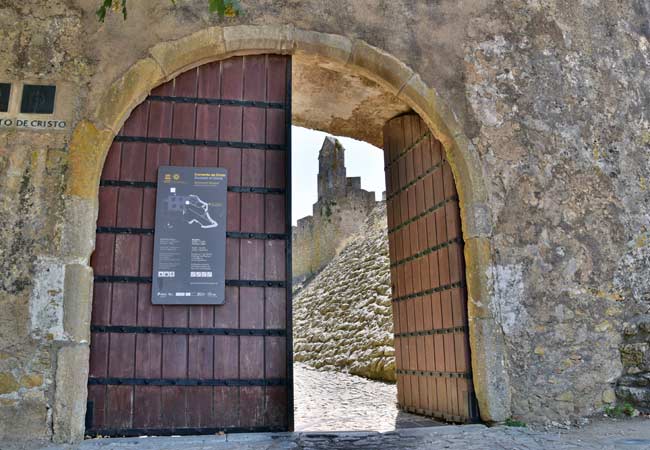
The castle walls that surround the Convento de Cristo
When the Templars were dissolved in 1312, the complex found new life as the headquarters of the Order of Christ under Prince Henry the Navigator's patronage. This period marked the beginning of significant architectural expansions, including the magnificent Manueline window – a masterpiece of Portuguese Late Gothic architecture that incorporates maritime motifs celebrating the Age of Discoveries.
The interior of the Charola showcases stunning 16th-century religious paintings and gilt decorations, while the complex's eight cloisters demonstrate various architectural styles from Gothic to Renaissance. The Chapter House's ornate Manueline portal serves as a testament to Portugal's golden age of exploration.
Visitors typically spend 1.5-2 hours exploring this architectural marvel, with an entrance fee of €10.
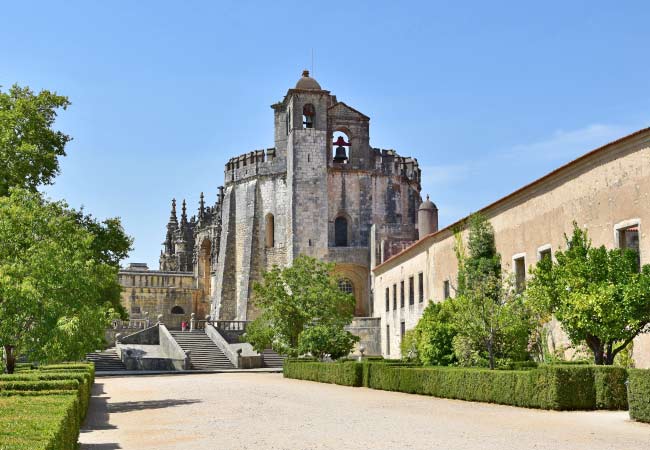
The inner courtyard of the Convento de Cristo
Museu dos Fósforos
This unique museum houses the world’s largest collection of matchboxes and matchbook covers, with over 43,000 pieces gathered from over 120 countries. What started as Aquiles da Mota Lima's personal collection in 1953 has grown into a fascinating showcase of commercial art and social history.
These tiny artworks reflect changing artistic styles, advertising trends and social history through their elaborate designs, making this quirky museum an unexpected cultural treasure in Tomar.
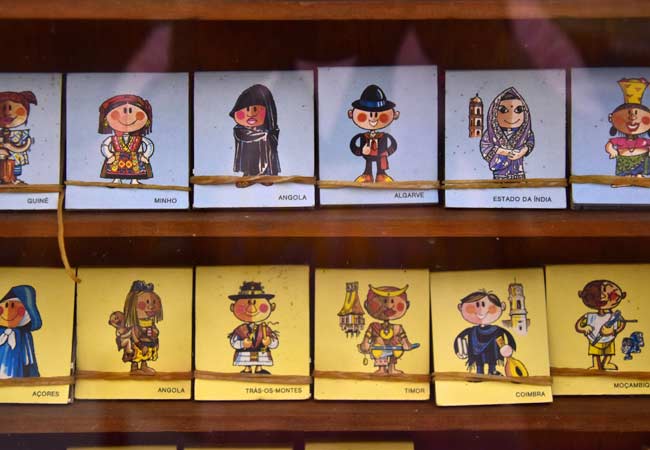
The huge collection of match boxes in the Museu dos Fósforos
Parque do Mouchão
The picturesque Parque do Mouchão lies on the banks of the Nabão River, offering beautiful views across the weir and town. This tree-lined park is an ideal spot to rest during a day of sightseeing and is particularly popular with Portuguese families.
The park's centrepiece is an impressive wooden waterwheel, which has become its defining symbol. Though decorative today, it commemorates Tomar's historical reliance on water power for milling and other industries.
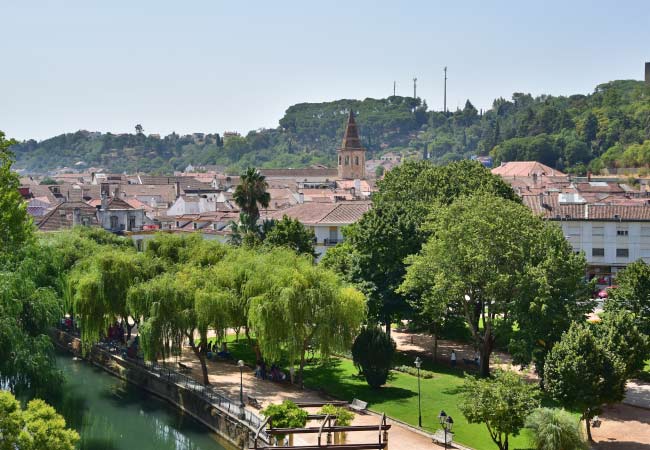
The Parque do Mouchão follows the banks of the Nabão river
Igreja de Santa Maria do Olival
The Igreja de Santa Maria do Olival is one of Portugal's most significant Gothic churches and served as the main church of the Knights Templar. It was the burial site for Templar knights, including their grand masters, making it a significant religious site for their order. The church is the final resting place of Gualdim Pais, the Templar Knight who founded Tomar.
The Santa Maria do Olival's western façade features a large rose window that influenced many others throughout Portugal, including the one at Jerónimos Monastery in Lisbon.
The church earned the nickname "Mother of All Templar Churches" as it functioned as the spiritual headquarters for Portugal's Templar activities. Inside, the three-nave interior leads to a main chapel containing medieval tombs of Templar masters, including Gualdim Pais, who founded Tomar in 1160.
The 14th-century bell tower, which locals still call the "Lighthouse of the Templars", stands apart from the main building and once guided travellers to the city.

Praça da República
The Praça da República is the main square of Tomar and is flanked some of the most important buildings of the town.
The impressive town hall stands at one end, while the Igreja de São João Baptista stands at the opposite end. At the center of the plaza stands a statue of Gualdim Pais, the Knights Templar master who founded Tomar in the 12th century.
The plaza is adorned with traditional Portuguese cobblestone pavement, featuring elegant black and white patterns in the calçada Portuguesa style, while a decorative 17th-century Renaissance fountain adds to its charm.
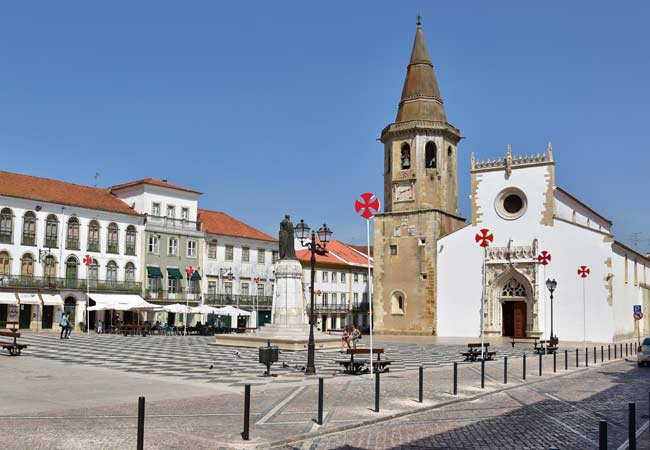
The pretty Praça da República is the heart of Tomar
Capela de Santa Iria
The chapel is dedicated to Saint Iria (Saint Irene), a martyr from the 7th century. According to legend, she was a nun who met a tragic end due to her vow of chastity. The story goes that she was falsely accused and subsequently killed by being thrown into the Nabão River, which flows through Tomar. Her body is said to have been carried downstream until it was found near Santarém, where a shrine was later built in her honour.
The chapel stands on the bank of the Nabão River, near the Ponte Velha (Old Bridge), and is noted for its modest yet charming Gothic and Manueline architectural details.
Sinagoga de Tomar
The Sinagoga de Tomar, built in 1438, is one of the best-preserved medieval synagogues in Portugal. The plain limestone exterior gives way to a striking prayer hall supported by four elegant columns, which represent Sarah, Rebecca, Rachel and Leah - the matriarchs of Israel. Women would have worshipped from the upper gallery, while men gathered below beneath the impressive Gothic vaulting. The synagogue now houses a small Jewish museum that tells the story of Portugal's Jewish community, who flourished here until forced conversion in 1496.

Places to visit while on holiday to Tomar
While staying longer in Tomar, consider exploring these worthwhile attractions in the wider region:
São Martinho do Porto
A seaside town wrapped around a perfectly curved, shell-shaped bay. The calm, protected waters make this beach ideal for families, while the long boardwalk lined with restaurants provides a pleasant setting for evening strolls.
Nazaré
A fishing town turned surf mecca where traditional Portuguese culture meets world-record waves. The lower town offers a broad beach and excellent seafood restaurants, while the clifftop district of Sitio, reached by funicular, provides spectacular coastal views. The famous giant waves arrive between October and March.
Óbidos
A wonderfully preserved medieval town circled by ancient walls. Its maze of cobbled streets, lined with whitewashed houses and bright flowers, seems frozen in time. While popular with day-trippers, it's most enchanting in the early morning or late afternoon when the crowds thin.
Grutas de Mira de Aire
Portugal's most extensive cave system, which descends 180 meters underground. The hour-long guided tours take you past underground lakes and dramatic rock formations illuminated to highlight their natural beauty. A constant 17°C temperature makes these caves a refreshing escape on hot summer days.
Salinas de Rio Maior
These fascinating inland salt pans have been in continuous use since medieval times. The site's distinctive wooden structures and white salt mounds create an unusual landscape, while the traditional harvesting methods remain unchanged through centuries.
Mosteiro de Alcobaça
A UNESCO-listed monastery that houses Portugal's largest church. The austere Gothic architecture contrasts with elaborate touches like the massive medieval kitchen and the ornate tombs of Pedro and Inês - Portugal's own Romeo and Juliet. The monastery's scale and craftsmanship make it one of the country's most impressive religious buildings.
Mosteiro da Batalha
Another UNESCO World Heritage site that showcases the height of Gothic and Manueline architecture. Built to commemorate Portugal's victory at Aljubarrota in 1385, its intricate stonework and soaring spaces reflect the kingdom's power and wealth. The unfinished chapels provide a fascinating glimpse into medieval construction methods.
Grutas de Santo António
These limestone caves reveal a hidden world of stalactites, stalagmites, and underground pools. The 45-minute guided tours are fully accessible and well-lit, making it easy to appreciate the cave's natural sculptures. Like other caves in the region, they maintain a year-round temperature of 16-18°C.
Discover more of central Portugal with our guides
If you've found our content valuable, we'd welcome your support.
The digital publishing landscape has evolved significantly. As a small independent publisher, we face growing challenges. Search engines increasingly favour paid content over organic results, while AI-generated content often reproduces original work without attribution.
To support our work, please consider bookmarking this page (press Ctrl + D) for quick access. If you find an article helpful, we'd be grateful if you'd share it with friends on social media.
For specific questions, please see our Reddit community at r/LisbonPortugalTravel.
Should you notice any outdated or incorrect information, please contact us at [email protected]
Thank you for helping us continue to provide valuable content in an increasingly challenging digital environment.

























